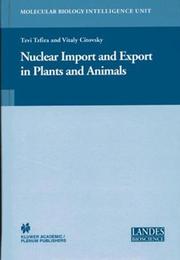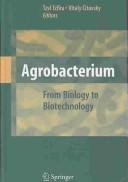| Listing 1 - 6 of 6 |
Sort by
|

ISBN: 1417582758 1280800089 9786610800087 0387277471 030648241X 1441934405 Year: 2005 Publisher: Georgetown, Tex., U.S.A. : New York, N.Y. : Landes Bioscience/Eurekah.com ; Kluwer Academic/Plenum Publishers,
Abstract | Keywords | Export | Availability | Bookmark
 Loading...
Loading...Choose an application
- Reference Manager
- EndNote
- RefWorks (Direct export to RefWorks)
Nuclear Import and Export in Plants and Animals provides insight into the remarkable mechanisms of nuclear import and export. This book covers a range of topics from the nuclear pore structure, to nuclear import and export of macromolecules in plant and animal cells. In addition, the book covers the special cases of nuclear import of Agrobacterium T-DNA during plant genetic transformation, nuclear import and export of animal viruses, and nuclear intake of foreign DNA. A chapter on research methods to study nuclear transport concludes the book.
Nuclear membranes. --- Biological transport. --- Proteins --- Physiological transport. --- Membrane transport --- Passive transport, Biological --- Physiological transport --- Transport, Biological --- Diffusion --- Osmosis --- Nuclear envelope --- Cell membranes --- Cell nuclei --- Cytology. --- Cell Biology. --- Cell biology --- Cellular biology --- Biology --- Cells --- Cytologists --- Cell biology.

ISBN: 1281141291 9786611141295 0387722904 0387722890 1441924736 Year: 2008 Publisher: New York : Springer,
Abstract | Keywords | Export | Availability | Bookmark
 Loading...
Loading...Choose an application
- Reference Manager
- EndNote
- RefWorks (Direct export to RefWorks)
Agrobacterium is the only cellular organism on Earth that is naturally capable of transferring genetic material between the kingdoms of life, from prokaryotes to eukaryotes. Studies have uncovered a wealth of information on the process of Agrobacterium-mediated genetic transformation and on the bacterial and host cell factors involved in the infection. Agrobacterium has been shown to genetically transform, under laboratory conditions a large number of plant species and numerous non-plant organisms, indicating the truly basic nature of the transformation process. It is therefore not surprising that Agrobacterium and the genetic transformation itself have also become the focus of numerous ethical and legal debates. ‘Agrobacterium’ is a comprehensive book on Agrobacterium research, including its history, application, basic biology discoveries, and effects on human society. Although the book largely focuses on providing a detailed review of virtually all molecular events of the genetic transformation process, it also provides coverage of ethical and legal issues relevant to the use of Agrobacterium as a "genetic transformation machine". The result is an all-inclusive text which readers—including scientists and students involved in plant genetic engineering—will find useful as a reference source for all major aspects of the Agrobacterium-mediated genetic transformation of plant and non-plant organisms. About the Editors: Dr. Tzvi Tzfira is an Assistant Professor in the Department of Molecular, Cellular, and Developmental Biology at the University of Michigan. Dr. Vitaly Citovsky is a Professor in the Department of Biochemistry and Cell Biology at Stony Brook University.
Agrobacterium. --- Polymonas --- Rhizobiaceae --- Botany. --- Bacteriology. --- Biotechnology. --- Plant genetics. --- Plant diseases. --- Agriculture. --- Plant Sciences. --- Plant Genetics and Genomics. --- Plant Pathology. --- Farming --- Husbandry --- Industrial arts --- Life sciences --- Food supply --- Land use, Rural --- Botany --- Communicable diseases in plants --- Crop diseases --- Crops --- Diseases of plants --- Microbial diseases in plants --- Pathological botany --- Pathology, Vegetable --- Phytopathology --- Plant pathology --- Plants --- Vegetable pathology --- Agricultural pests --- Crop losses --- Diseased plants --- Phytopathogenic microorganisms --- Plant pathologists --- Plant quarantine --- Genetics --- Chemical engineering --- Genetic engineering --- Microbiology --- Botanical science --- Phytobiology --- Phytography --- Phytology --- Plant biology --- Plant science --- Biology --- Natural history --- Pathology --- Diseases and pests --- Diseases --- Wounds and injuries --- Plant science. --- Plant pathology. --- Floristic botany
Digital
ISBN: 9780387277479 Year: 2005 Publisher: Boston, MA Eurekah.com and Kluwer Academic / Plenum Publishers
Abstract | Keywords | Export | Availability | Bookmark
 Loading...
Loading...Choose an application
- Reference Manager
- EndNote
- RefWorks (Direct export to RefWorks)
Histology. Cytology --- cytologie --- histologie
Digital
ISBN: 9780387722900 Year: 2008 Publisher: New York, NY Springer Science+Business Media, LLC
Abstract | Keywords | Export | Availability | Bookmark
 Loading...
Loading...Choose an application
- Reference Manager
- EndNote
- RefWorks (Direct export to RefWorks)
Book
ISBN: 9780387277479 Year: 2005 Publisher: Boston MA Springer US
Abstract | Keywords | Export | Availability | Bookmark
 Loading...
Loading...Choose an application
- Reference Manager
- EndNote
- RefWorks (Direct export to RefWorks)
Nuclear Import and Export in Plants and Animals provides insight into the remarkable mechanisms of nuclear import and export. This book covers a range of topics from the nuclear pore structure, to nuclear import and export of macromolecules in plant and animal cells. In addition, the book covers the special cases of nuclear import of Agrobacterium T-DNA during plant genetic transformation, nuclear import and export of animal viruses, and nuclear intake of foreign DNA. A chapter on research methods to study nuclear transport concludes the book.
Histology. Cytology --- cytologie --- histologie
Book
ISBN: 9780387722900 Year: 2008 Publisher: New York NY Springer New York
Abstract | Keywords | Export | Availability | Bookmark
 Loading...
Loading...Choose an application
- Reference Manager
- EndNote
- RefWorks (Direct export to RefWorks)
Agrobacterium is the only cellular organism on Earth that is naturally capable of transferring genetic material between the kingdoms of life, from prokaryotes to eukaryotes. Studies have uncovered a wealth of information on the process of Agrobacterium-mediated genetic transformation and on the bacterial and host cell factors involved in the infection. Agrobacterium has been shown to genetically transform, under laboratory conditions a large number of plant species and numerous non-plant organisms, indicating the truly basic nature of the transformation process. It is therefore not surprising that Agrobacterium and the genetic transformation itself have also become the focus of numerous ethical and legal debates. Agrobacterium' is a comprehensive book on Agrobacterium research, including its history, application, basic biology discoveries, and effects on human society. Although the book largely focuses on providing a detailed review of virtually all molecular events of the genetic transformation process, it also provides coverage of ethical and legal issues relevant to the use of Agrobacterium as a "genetic transformation machine". The result is an all-inclusive text which readers including scientists and students involved in plant genetic engineering will find useful as a reference source for all major aspects of the Agrobacterium-mediated genetic transformation of plant and non-plant organisms. About the Editors: Dr. Tzvi Tzfira is an Assistant Professor in the Department of Molecular, Cellular, and Developmental Biology at the University of Michigan. Dr. Vitaly Citovsky is a Professor in the Department of Biochemistry and Cell Biology at Stony Brook University.
| Listing 1 - 6 of 6 |
Sort by
|

 Search
Search Feedback
Feedback About UniCat
About UniCat  Help
Help News
News